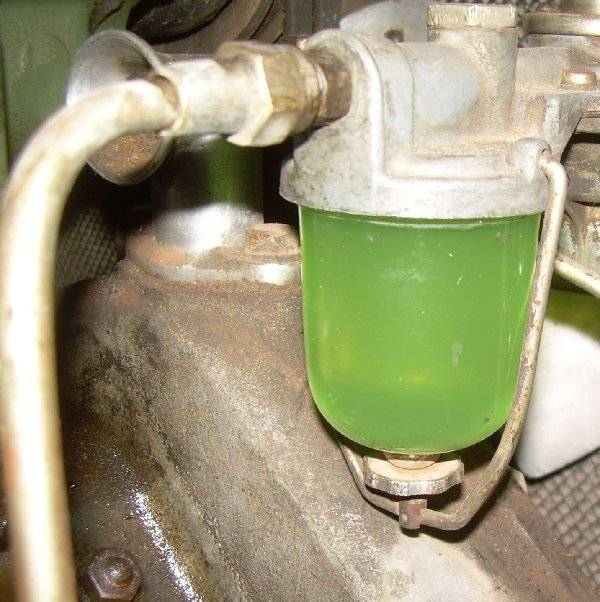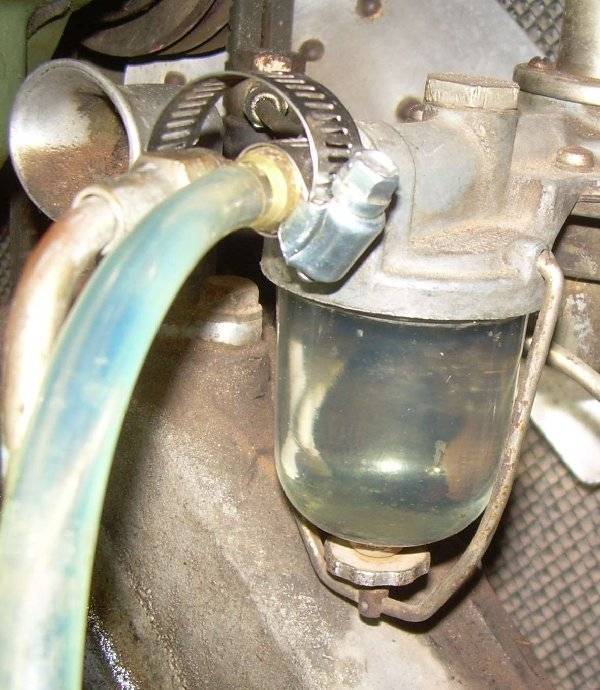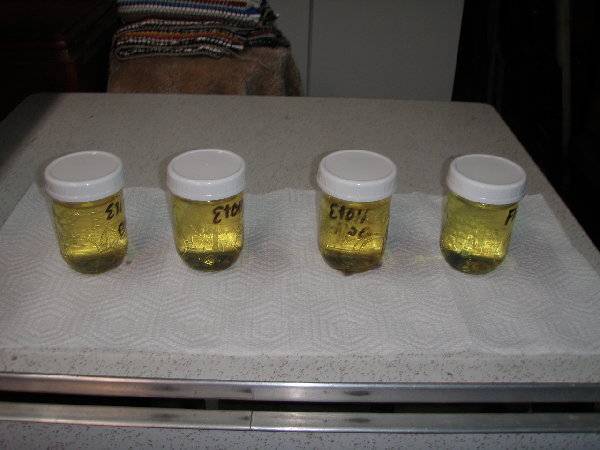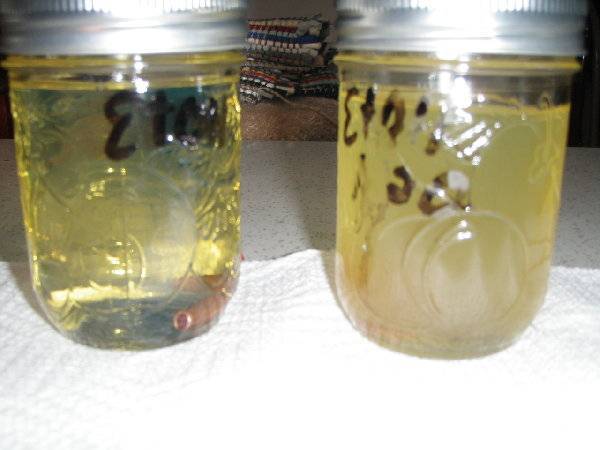|
Re: Bright green gas
|
||||
|---|---|---|---|---|
|
Home away from home

|
Wow. Previously owned by Linda Blair?
Posted on: 2017/12/1 21:48
|
|||
|
||||
|
Re: Bright green gas
|
||||
|---|---|---|---|---|
|
Home away from home
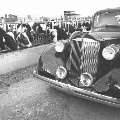
|
It's about the same color as antifreeze.
Posted on: 2017/12/1 22:12
|
|||
|
I can explain it to you but I can't understand it for you
 Bad company corrupts good character! Farming: the art of losing money while working 100 hours a week to feed people who think you are trying to kill them |
||||
|
||||
|
Re: Bright green gas
|
||||
|---|---|---|---|---|
|
Forum Ambassador

|
Time to drop the gas tank and have it boiled out and inspected.
Posted on: 2017/12/2 10:04
|
|||
|
||||
|
Re: Bright green gas
|
||||
|---|---|---|---|---|
|
Home away from home
|
You can analyze the stuff, but the cloudiness suggests (to me) there's moisture in the fuel system.
Color in organics is one of the hardest things to pin down, but you can get good clues from a UV/visible scan and look at the absorbance bands and reference them. Not your garden variety auto shop tool. Chemists will know what I say. But spare getting the answer, you will find evidence of trace water and subsequent corrosion in fuel system, I'm sure. So rethink your level of "determined the tank is clean". Otherwise, it would look like it did, when you put it in.
Posted on: 2017/12/2 11:28
|
|||
|
||||
|
Re: Bright green gas
|
||||
|---|---|---|---|---|
|
Home away from home
|
Tank is clean as a whistle inside. Turns out this is the explanation: old gas in the copper fuel lines turns to green goo. Fortunately, the stuff in my lines washed away quite easily. Thanks to David M for this document explaining the effect of modern (circa 1970) gasoline on copper.
Posted on: 2018/7/30 17:37
|
|||
|
Rob
1930 Custom 8 Club Sedan |
||||
|
||||
|
Re: Bright green gas
|
||||
|---|---|---|---|---|
|
Forum Ambassador

|
Always something new in this hobby, up to this point I'd never seen or heard of green gas.
Posted on: 2018/7/30 18:43
|
|||
|
||||
|
Re: Bright green gas
|
||||
|---|---|---|---|---|
|
Home away from home
|
Since that link was rather old, I've decided to conduct a little experiment with today's pump gas. I got 89 ethanol, 89 non-ethanol(free), and will spike one ethanol with a little (~1%) H2O. And use equal lengths of soft copper tubing as the test specimen. I'll stick one brass fitting in one as a control.
It's the rage to use the EZ bend cupro-nickle tubing today, but I worked for the guys pushing nylon 12 fuel line and we did gas testing in the R&D lab. I(technology) had to store/furnish the gas and it was all inert so as not contaminate the fuel. Of course, I don't have the lab access I once had, so we'll have to forego analyses and look at color/specimen condition only. I'll post the pictures when there's some results. organo-metal cluster complexes absorb in the <400 nm region and is what produces the green or whatever color it's causing. Easy to run on the UV-vis.
Posted on: 2018/7/31 12:18
|
|||
|
||||
|
Re: Bright green gas
|
||||
|---|---|---|---|---|
|
Home away from home
|
Most interested to find out the results of your experiment, Fish'n Jim.
Posted on: 2018/7/31 14:39
|
|||
|
Rob
1930 Custom 8 Club Sedan |
||||
|
||||
|
Re: Bright green gas
|
||||
|---|---|---|---|---|
|
Home away from home
|
If you're expecting nice clear colorless gasoline, you're unfortunately mistaken in this day and age.
These are the starting jars. 3 Ethanol(EtOH) on the left, but not immediately distinguishable by color compared to EtOH free. As you can see, it's bright yellow to start with. The cloudy one is the one with 1 vol% water which by the way does not dissolve, and upon shaking becomes turbid as shown. What happens is H2O extracts some of the EtOH and forms a separate phase layer. That's why I suspected the green gas had water in it, but it could be particulate. These gasolines were obtained locally by me in 14 gal EtOH, 5 gal EtOH free, quantities from the Shell station within the last 2 weeks. The ethanol free is listed as a non-Shell product. Gas in this area comes from Tx via pipeline. I suspect it has a fair amount of iron in it, but only parts of a ppm Fe are needed to impart yellow. There's also the additives that could be giving color. [I'm not sure if it's coming from dye in these cases(89 octane rated) for inventory purposes, either.] There's a comparative color scale they use for specs, and I used to have it eyeballed but I'm far removed from that now. I'll leave these capped up*, no air and if nothing happens, then I'll vent them to let air in as you'd have in your tank. Doesn't look like it'll take much to change the hue to green, but I never intentionally bias the experiments. For the record, there's 200 ml of gas in each, and 2 x (2.3 gm ea) 1" of 1/4 Cu tube, all I did was rinse in gas and dry excess. The brass is two 1/8" male flare nuts. Temperature 80F. ps: you have to also consider the distribution and most comes from terminals and the trucks carry different grades in the same truck and usually without cleaning between loads. Blending for brand additives is allowed. But I've seen the same fuel, from the same tank, go from the brand station to the independent unbranded station back in the day. * - I put the metal lids(canning type) on after the photos as the plastic were leaking a bit. I don't need a fire in the garage.
Posted on: 2018/7/31 20:48
|
|||
|
||||

 (169.22 KB)
(169.22 KB)